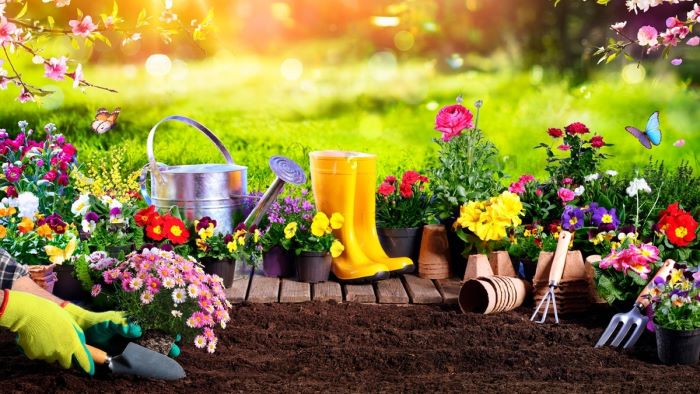Spring is here, and it’s time to prepare your home garden for the new season. But before you start planting, pruning, and mulching, you need to do some spring cleaning. This will help ensure that your garden is healthy and beautiful.
Spring cleaning your garden is not just about removing the dead leaves and weeds that have accumulated over the winter. It’s also about preparing the soil, checking the irrigation system, repairing any damage, and caring for any pests or diseases.
So, to help you out, we have jotted down a spring cleaning checklist for the home garden, which will help you tackle these tasks easily. Whether you have a small balcony garden or a large backyard, this checklist will help you make your garden look its best, and ready for the warmer months ahead.
Grab your gloves, tools, and let’s get started! 😊
Contents
- 1 11 Spring Cleaning Tips for Home Garden
- 1.1 1. Remove Debris
- 1.2 2. Prune Shrubs
- 1.3 3. Cut Back Perennials
- 1.4 4. Divide and Transplant
- 1.5 5. Care for Roses
- 1.6 6. Clean Up Ornamental Grasses
- 1.7 7. Weed and Mulch Your Garden Beds
- 1.8 8. Test Soil and Fertilizer as Needed
- 1.9 9. Clean Up Your Vegetable Beds
- 1.10 10. Plant Spring Bulbs and Flowers
- 1.11 11. Maintain Your Tools and Equipment
- 2 FAQs
- 3 Conclusion
11 Spring Cleaning Tips for Home Garden
Spring cleaning your garden involves removing any debris, pruning shrubs, cutting back perennials, and many other essential tips. So, to help you out, we have done some good research work regarding tips for spring cleaning garden.
We will go over each of the important spring clean up tasks in detail to make your garden look healthy and beautiful.
1. Remove Debris
The first thing to do when you clean your garden in the spring is to get rid of any trash that accumulated over the winter. This includes fallen branches, leaves, rocks, trash, or any other unwanted materials, which may hinder the growth of your plants or harbor pests and diseases.

In addition, you can use a rake, a broom, or a leaf blower to collect the debris, and dispose of it in a compost pile or a trash bin.
Removing the debris will also help you see the condition of your plants and soil better.🍃
2. Prune Shrubs
Another important step of spring cleaning your garden is to prune any shrubs that need shaping or trimming. Pruning helps improve the health and appearance of your shrubs by removing dead, diseased, or damaged branches, encouraging new growth, and enhancing air circulation.
The best time to prune shrubs depends on their type and flowering season. It is recommended to prune spring-flowering shrubs after they finish blooming. Or fall-flowering shrubs in late winter or early spring.
We advise you to use pruning shears, loppers, or a pruning saw to cut the branches at an angle just above a bud or a branch collar.✂️🍃
3. Cut Back Perennials
Perennials are plants that come back year after year from their roots. Some perennials die back to the ground in winter, while others retain some foliage throughout the year. To keep your perennials healthy and tidy, you need to cut back any dead or damaged stems and leaves in spring.
Furthermore, this procedure will stimulate new growth and prevent diseases from spreading. We recommend you use scissors, pruning shears, or a knife to cut back the perennials to about 2-3 inches above the ground or the base of the plant.
4. Divide and Transplant
Spring is also a good time to divide and transplant some of your perennials that have become overcrowded or outgrown their space. As dividing perennials helps rejuvenate them by reducing competition for nutrients, water, and light. It also allows you to propagate new plants for free.

Furthermore, to divide perennials, you need to dig up the entire clump with a spade or a fork, shake off the excess soil, and split it into smaller sections with your hands or a knife. Make sure each section has some roots and shoots attached.
On the other hand, transplanting perennials means moving them from one location to another in your garden. To transplant perennials, you need to dig up the plant with as much root balls as possible with a spade or a fork.
5. Care for Roses
Roses are one of the most popular and beautiful flowers in any garden. But they also require some special care in spring to ensure they bloom profusely and stay healthy throughout the season. The main tasks involved in caring for roses are pruning, fertilizing, mulching, watering, and pest control.
6. Clean Up Ornamental Grasses
Ornamental grasses are plants that have long, slender leaves and showy seed heads, which add texture, color, movement, and sound to your garden. These are low-maintenance plants that require little care once established. However, they do need some spring cleaning to remove any dead or brown foliage and make room for new growth.

The best time to clean up ornamental grasses is in late winter or early spring before they start to green up. Additionally, you can use pruning shears, scissors, a knife, or a hedge trimmer to cut back the ornamental grasses to about 4-6 inches above the ground.
Related Post: Vegetable gardening tips! Zucchini growing tips!
7. Weed and Mulch Your Garden Beds
Weeding and mulching your garden beds are essential tasks for spring cleaning your garden. Weeding helps eliminate any unwanted plants that compete with your desired plants for space, nutrients, water, and light. On the other hand, mulching helps conserve soil moisture, moderate soil temperature, suppress weeds, and improve soil structure and fertility.
The best time to weed your garden beds is in early spring, when the weeds are young and easy to pull out. You can use a hoe, a cultivator, a weeder, or your hands to remove the weeds from the soil. In addition, make sure you get rid of the entire root system of the weeds to prevent them from regrowing.
Furthermore, the best time to mulch your garden beds is also in early spring, after you weed them and when the soil is moist. You can use organic materials such as shredded bark, wood chips, pine needles, straw, or grass clippings as mulch.
8. Test Soil and Fertilizer as Needed
Testing soil and fertilizing as needed are important steps for spring cleaning your garden. Testing soil helps you determine the pH level and nutrient content of your soil, which affect the health and growth of your plants. Fertilizing as needed helps provide your plants with the nutrients they need to grow and bloom well.
You can use a home soil test kit or send a soil sample to a laboratory for analysis. The results will tell you the pH level and nutrient content of your soil, as well as any amendments or fertilizers you need to add to improve it.
The best time to fertilize your garden depends on the type and needs of your plants. Generally,
- You should fertilize annuals, vegetables, fruits, and herbs every 2-4 weeks during the growing season with a balanced granular or liquid fertilizer.
- Fertilize perennials, bulbs, roses, and shrubs once or twice during the growing season with a slow-release granular fertilizer.

- You should fertilize trees once or twice a year in early spring and late fall with a granular fertilizer specially formulated for trees.
- Avoid fertilizing any plants late in the season, as this may stimulate tender growth that can be damaged by frost.
Follow the label instructions for the amount and frequency of application of any fertilizer you use. You can also use organic fertilizers such as compost, manure, or fish emulsion to enrich your soil and feed your plants.
9. Clean Up Your Vegetable Beds
Cleaning up your vegetable beds is another task for spring cleaning your garden. It involves removing any dead or diseased plants, weeds, debris, or mulch from the previous season, preparing the soil for planting, and planting new crops or seeds.
It is recommended to use a tiller, a spade, or a fork to loosen and aerate the soil, adding any amendments or fertilizers as needed according to your soil test results.
10. Plant Spring Bulbs and Flowers
The best time to plant spring bulbs is in fall, before the ground freezes. However, you can also plant pre-chilled bulbs in early spring if you missed the fall planting window. Plus, you can use a bulb planter, a trowel, or a spade to dig holes that are 2-3 times deeper than the height of the bulb. Then place the bulb in the hole with the pointed end up and cover it with soil.

On the other hand, the best time to plant spring flowers is in early spring, after the last frost date in your area. You can choose from various types of spring flowers such as pansies, primroses, daffodils, tulips, hyacinths, crocuses, irises, or lilacs.
11. Maintain Your Tools and Equipment
Maintaining your tools and equipment is the final task for spring cleaning your garden. It helps extend their lifespan, improve their performance, and prevent injuries or accidents. You can use a wire brush, a rag, a file, a sharpening stone, or a lubricant to clean, sharpen, and oil your tools and equipment.
FAQs
When should I start cleaning my garden in the spring?
Depends on your climate and the type of plants you have in your garden. Generally, you should start cleaning your garden in the spring when the soil is workable and the danger of frost has passed. However, some tasks such as pruning shrubs, cutting back perennials, dividing and transplanting plants, or planting spring bulbs can be done earlier or later depending on their specific requirements.
Should you remove leaves from flower beds in spring?
You should remove leaves from flower beds in spring if they are thick, wet, matted, or diseased, as they may smother, rot, or infect your plants. Or you can leave leaves in flower beds in spring if they are thin, dry, shredded, or healthy, as they may act as a natural mulch that protects, insulates, and nourishes your plants.
Conclusion
You have just completed the spring cleaning checklist for the garden. Congratulations!
By following these 11 spring cleaning checklist for the garden, you can ensure that your garden is healthy, tidy, and beautiful throughout the year. Your plants will thank you for giving them a fresh start and a healthy environment.
Happy Gardening!

Hello, I’m Rose Lehman, the content writer of cozynest. I have been a gardener for over 5 years, and I have a certificate in master gardening from the Oregon State University Extension Service. I enjoy writing about all aspects of gardening, from the basics to the advanced, and from the practical to the creative. I also love to explore different types of gardens, cultures, and styles, and share them with our readers. My goal is to inspire and inform our audience, and help them grow their own cozynest.

